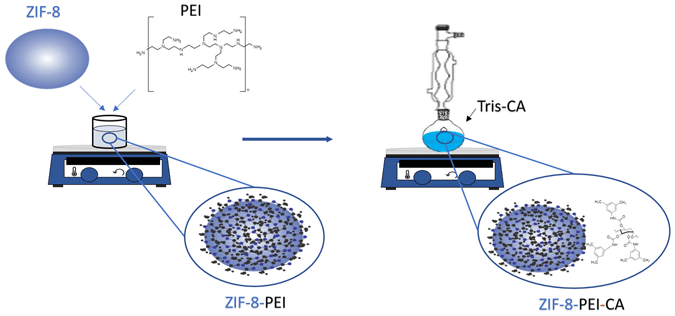Crossref Citations
This article has been cited by the following publications. This list is generated based on data provided by
Crossref.
Santos, Kátilla M.C.
Menezes, Tamires R.
Oliveira, Marília R.
Silva, Thauane S.L.
Santos, Klebson S.
Barros, Vinicius A.
Melo, Darley C.
Ramos, André L.
Santana, Cesar C.
Franceschi, Elton
Dariva, Cláudio
Egues, Silvia M.
Borges, Gustavo R.
and
De Conto, Juliana F.
2021.
Natural gas dehydration by adsorption using MOFs and silicas: A review.
Separation and Purification Technology,
Vol. 276,
Issue. ,
p.
119409.
Taima-Mancera, Iván
and
Pino, Verónica
2021.
Reticular materials as chiral stationary phases in chromatography.
Journal of Chromatography Open,
Vol. 1,
Issue. ,
p.
100002.
Hassanpour, Soodabeh
Niaei, Navid
and
Petr, Jan
2022.
Metal–Organic Frameworks-Based Analytical Devices for Chiral Sensing and Separations: A Review (2012–2022).
Chemosensors,
Vol. 11,
Issue. 1,
p.
29.
Yan, Yi-Lun
Guo, Dong
Wu, Jia-Lin
Tang, Xi-Hao
Luo, Jia-Jun
Li, Shu-Qing
Fan, Jun
Zheng, Sheng-Run
Zhang, Wei-Guang
and
Cai, Song-Liang
2022.
Fabrication of cellulose derivative coated spherical covalent organic frameworks as chiral stationary phases for high-performance liquid chromatographic enantioseparation.
Journal of Chromatography A,
Vol. 1675,
Issue. ,
p.
463155.
Ding, Rui
Wang, Qiuchen
Ruan, Xuehua
Dai, Yan
Li, Xiangcun
Zheng, Wenji
and
He, Gaohong
2022.
Novel and versatile PEI modified ZIF-8 hollow nanotubes to construct CO2 facilitated transport pathway in MMMs.
Separation and Purification Technology,
Vol. 289,
Issue. ,
p.
120768.
Li, Guoqiang
Kujawski, Wojciech
Tonkonogovas, Andrius
Knozowska, Katarzyna
Kujawa, Joanna
Olewnik-Kruszkowska, Ewa
Pedišius, Nerijus
and
Stankevičius, Arūnas
2022.
Evaluation of CO2 separation performance with enhanced features of materials – Pebax® 2533 mixed matrix membranes containing ZIF-8-PEI@[P(3)HIm][Tf2N].
Chemical Engineering Research and Design,
Vol. 181,
Issue. ,
p.
195.
Liu, Huifeng
Chen, Jia
Chen, Mingli
Wang, Jianhua
and
Qiu, Hongdeng
2023.
Recent development of chiral ionic liquids for enantioseparation in liquid chromatography and capillary electrophoresis: A review.
Analytica Chimica Acta,
Vol. 1274,
Issue. ,
p.
341496.
Menezes, Tamires R.
Santos, Kátilla M.C.
Silva, Thauane S.L.
Santos, Klebson S.
Ramos, André L.
Borges, Gustavo R.
Franceschi, Elton
Dariva, Cláudio
De Conto, Juliana F.
Egues, Silvia M.
and
Santana, Cesar C.
2023.
Carbon dioxide and methane capture in metal-organic framework MIL-101(Cr) at high pressure.
Gas Science and Engineering,
Vol. 119,
Issue. ,
p.
205136.
YAN, Meiting
LONG, Wenwen
TAO, Xueping
WANG, Dan
XIA, Zhining
and
FU, Qifeng
2023.
Research progress on the construction and applications of metal-organic frameworks in chromatographic stationary phases.
Chinese Journal of Chromatography,
Vol. 41,
Issue. 10,
p.
879.
Anvari Kohestani, Abolfazl
and
Pishbin, Fatemehsadat
2023.
3D Printing of Bone Scaffolds Based on Alginate/Gelatin Hydrogel Ink Containing Bioactive Glass 45S5 and ZIF‐8 Nanoparticles with Sustained Drug‐Release Capability.
Advanced Engineering Materials,
Vol. 25,
Issue. 21,
Cheng, Qingsong
Ma, Qian
Pei, Hebing
Liang, Hao
Zhang, Xuejiao
Jin, Xuening
Liu, Nijuan
Guo, Ruibin
and
Mo, Zunli
2023.
Chiral metal-organic frameworks materials for racemate resolution.
Coordination Chemistry Reviews,
Vol. 484,
Issue. ,
p.
215120.
Liu, Chunqiang
Quan, Kaijun
Chen, Jia
Shi, Xiaofeng
and
Qiu, Hongdeng
2023.
Chiral metal-organic frameworks and their composites as stationary phases for liquid chromatography chiral separation: A minireview.
Journal of Chromatography A,
Vol. 1700,
Issue. ,
p.
464032.
Wang, Zi-Xing
Guo, Bao-Ying
Chen, Shu-Yi
Liu, Wan-Ning
Ye, Wei-Ping
Cai, Song-Liang
Zheng, Sheng-Run
Fan, Jun
and
Zhang, Wei-Guang
2024.
Synthesis of spherical amorphous metal‒organic frameworks via an in situ hydrolysis strategy for chiral HPLC separation.
Journal of Solid State Chemistry,
Vol. 340,
Issue. ,
p.
125028.
Gu, Zhida
Luo, Yongqi
Zhang, Xinglong
Zhu, Zhiyi
Wang, Yuchen
Tang, Tao
Zhang, Suoying
and
Zhang, Weina
2024.
Preparation and applications of metal–organic frameworks in chiral chromatographic separation.
TrAC Trends in Analytical Chemistry,
Vol. 179,
Issue. ,
p.
117864.
Salahi, Fatemeh
Zarei-Jelyani, Fatemeh
Zarei-Jelyani, Mohammad
and
Rahimpour, Mohammad Reza
2024.
Advances in Natural Gas: Formation, Processing, and Applications.
p.
213.
Yang, Han
Liang, Fu-Chang
Tang, Bo
Chen, Hai-Xiong
Fu, Si-Yun
Cai, Song-Liang
Zhang, Wei-Guang
Fan, Jun
and
Zheng, Sheng-Run
2025.
Preparation of a metal‒organic framework glass‒based chiral stationary phase for HPLC enantiomer separation.
Journal of Solid State Chemistry,
Vol. 346,
Issue. ,
p.
125252.
Jia, Xiangze
Huang, Yanyan
Zhu, Jianzhong
Junejo, Shahid Ahmed
Zhang, Bin
and
Huang, Qiang
2025.
Fabrication of genipin cross-linked chitosan-ZIF-8 through emulsion templated approach for sulfanilamide removal.
Materials Science and Engineering: B,
Vol. 313,
Issue. ,
p.
117933.
Menezes, Tamires R.
Santos, Kátilla M.C.
Mao, Haiyan
Santos, Klebson
De Conto, Juliana F.
Reimer, Jeffrey A.
Dariva, Silvia M.E.
and
Santana, Cesar C.
2025.
Efficient separation of carbon dioxide and methane in high-pressure and wet gas mixtures using Zr-MOF-808.
Separation and Purification Technology,
Vol. 354,
Issue. ,
p.
129033.
Gawali, Sapna
Sinha, Manish Kumar
and
Jampa, Surendra Sasikumar
2025.
Modification and Optimization Study of ZIF‐8 with Branched Polyethyleneimine Modified Polysulfone Membrane.
Chemical Engineering & Technology,
